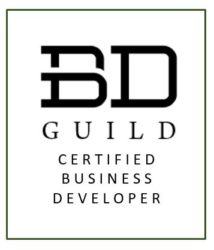 To give you an idea of the dynamic in the room during CBD modules, everyone in the room (I’m guessing 90%) work in a construction firm or construction-related trade. For the most part everyone has a company name recognizable to everyone else in the room, aside from the handful of emerging boutique firm owners, which we all know now of course. It’s comprised of consultants, subcontractors, national architects and builders. Now after getting the opportunity to chat with most everyone in the room, I’d guess about one in five are principals at their firm. This makes for excellent and detailed interjections, experience comments, and jokes only we could get! So, make sure you view the video recording provided by the BD Guild if you miss class.
To give you an idea of the dynamic in the room during CBD modules, everyone in the room (I’m guessing 90%) work in a construction firm or construction-related trade. For the most part everyone has a company name recognizable to everyone else in the room, aside from the handful of emerging boutique firm owners, which we all know now of course. It’s comprised of consultants, subcontractors, national architects and builders. Now after getting the opportunity to chat with most everyone in the room, I’d guess about one in five are principals at their firm. This makes for excellent and detailed interjections, experience comments, and jokes only we could get! So, make sure you view the video recording provided by the BD Guild if you miss class.
The beginning portion of Module 3 was delivered by Wylie Bearup, who currently serves as an AEC-focused professor and program director at ASU. His co-host was Tom Reilly, principal at Arkitecton. Wylie and Tom worked together as contractor and client during the construction of ASU’s Del Webb School of Construction. Arkitecton is based in Phoenix, with an office of about 30 public sector experts. The overall message of this portion of the presentation was a no-brainer, but one we so often forget – clients do not contractually need to be educated about design or construction at all, they only need to have money! It’s up to you as an educated and savvy business developer to ensure your clients are educated on the project delivery method that is most advantageous to their goals. Project delivery methods include Design-Build and Design-Bid-Build, CM@R, and more. A key differentiator is that a project delivery method has a project schedule associated with costs, while a financing arrangement, such as a P3, exists only to finance the project in a certain way and does not dictate the project delivery method utilized. In short, a P3 project could be completed as either a CM@R or as Design-Build, depending on the preference of the client. If a qualified client has a project need, could a business developer assist in putting a project in tangible motion? By educating a client on the PDM options available, could they influence the selection of a finance method, the selection of a qualified design and construction team, and inevitably the selection of themselves? Absolutely. Understanding their needs and budget, as well as your place in the food chain and opportunity for influence, is key.
The presentation even gave an interesting history of the evolution of a contractor. At the year 300 and for hundreds of years after, history describes a “master builder”. This highlights design-build as the original project delivery method. Around the 1800’s and during the skyscraper era, there was a rise in broken-out engineering and design firms, departing from the umbrella of builder corporations. It wasn’t until the 1960’s that lawyers began to get intricately involved in construction, ensuring that modern-day guidelines are enforced by law. If you’re interested in learning more about Arizona’s state procurement office rules for hiring contractors, you can read more on Title 28 (horizontal construction) and Title 34 (vertical), with Titles 41 & 15 addressing specific government entities like school districts. In 2005, there was a revision to these statutes addressing continued advancements in construction technology following industry expert input, and then in 2010 additional industry transparency was called for.
The second portion of Module 3 which covered return on relationships was delivered by Cynthia Wrasman, principal at Kelfi Catalyst. Attendees were taught how to prioritize relationships with targeted client mapping – which includes visualizing the source of your leads and establishing a cyclical approach to retention efforts of your non-direct “clients”. We know your lead management software (or lead management spreadsheet) should have columns for last follow up or next meeting, but it may not have columns for lead source or last lead source follow-up. Continued referrals could be an opportunity left without nurturing because you don’t give the same energy that you give the referred client themselves. To me, this was a genius reminder of a foundational concept. I was inspired to use Cynthia’s approach and create a quick referral map from a recent financial report. I found my business has such frequent referrals, that a small group of peers continues to have more power and influence over my bottom line than the same number of clients individually. However, I have no calculated retention efforts in place for those who are not considered traditional, “direct” clients. Thinking outside the box and having a better understanding of who I owe reciprocal time and energy, and knowing everyone who impacts my bottom line, was an excellent lesson in business development awareness. In both presentations, the lesson was being strategic with data and your approach will manifest more opportunities!